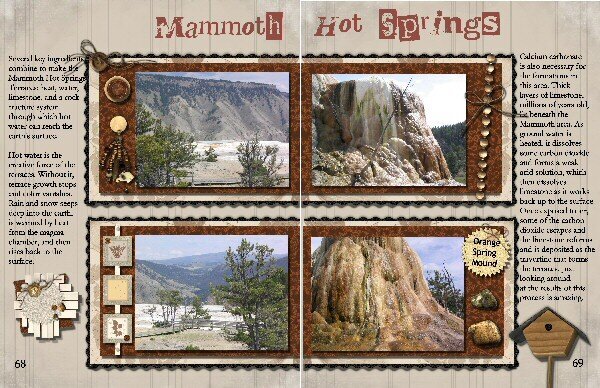Plus, a FREE Gift! | Details Here.


 Give a Cheer
Give a Cheer
One of the most fascinating areas of Yellowstone is the Mammoth Hot Springs. It is packed with unusual and weirdly colored rock areas and wet, steamy, smelly springs. These pages are from my vacation album which I am creating in the format of a magazine. Since both DH and I are both interested in science, the journaling in this magazine/album includes not only our observations, but some notes of interest about each area so we don’t forget. I am sure this is not everyone’s cup of tea, but it suits us well.
PAGE 1 JOURNALING READS: Several key ingredients combine to make the Mammoth Hot Springs Terraces: heat, water, limestone, and a rock fracture system through which hot water can reach the earth's surface.
Hot water is the creative force of the terraces. Without it, terrace growth ceases and color vanishes. Rain and snow seeps deep into the earth, is warmed by heat from the magma chamber, and then rises back to the surface.
PAGE 2 JOURNALING READS: Calcium carbonate is also necessary for the formations in this area. Thick layers of limestone, millions of years old, lie beneath the Mammoth area. As ground water is heated, it dissolves some carbon dioxide and forms a weak acid solution, which then dissolves limestone as it works back up to the surface. Once exposed to air, some of the carbon dioxide escapes and the limestone reforms and is deposited as the travertine that forms the terraces. Just looking around at the results of this process is amazing.
FONTS: Palatino Linotype, CK Newsclips, Garamond, Trebuchet
No products have been added to this project.
Thanks for spreading positivity!
August 28, 2006
August 29, 2005